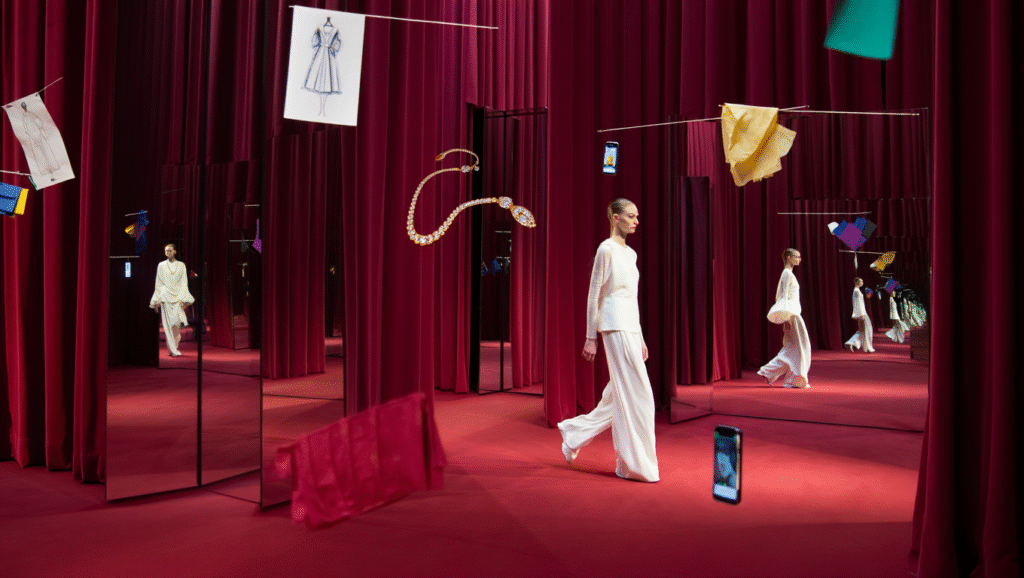London Fashion Week just wrapped, and I’m still processing the sensory overload. Three days of shows, installations, and after-parties have left me with a notebook full of observations and a head buzzing with ideas for the second novel. The fashion show has officially invaded my creative process, and I couldn’t be more grateful for the chaos.
I managed to slip into a few shows — not front row, obviously, but close enough to absorb the electricity that crackles when the industry’s most powerful players gather in one room. The experience was equal parts mesmerizing and unsettling, like watching a beautiful machine that occasionally reveals its grinding gears.
The runway shows are pure theater, each one a carefully orchestrated fifteen-minute universe. Models float down catwalks like ethereal beings, their faces blank canvases that somehow convey both supreme confidence and complete detachment. The clothes tell stories — some whisper, some shout, some speak in languages I’m still learning to decode.
But it’s what happens in the margins that fascinates me most. The backstage glimpses through partially open doors reveal a different reality: models being sewn into garments that weren’t quite finished, PR teams managing tiny crises with the intensity of diplomatic negotiations, designers whose hands shake slightly as they make final adjustments to pieces that represent months of their lives.
In the front rows, editors and influencers maintain perfect composure while frantically documenting every moment for immediate consumption. Their phones become extensions of their eyes, translating live experience into content before it’s fully experienced. The performance isn’t just on the runway — it’s in every seat, every carefully curated outfit, every calculated reaction.
The most striking moment came during a sustainable fashion panel I attended between shows. A designer whose work I’d admired for years spoke candidly about the industry’s environmental impact, then walked me through the mathematics of waste: the pounds of fabric discarded for each garment that makes it to market, the carbon footprint of flying models and buyers around the globe, the psychological toll of creating beauty in a system that thrives on perpetual dissatisfaction.
Her voice cracked slightly when she described visiting textile factories and seeing mountains of offcuts — gorgeous, expensive materials that would never become anything more than colorful waste. “We’re creating dreams,” she said, “but sometimes I wonder if we’re selling nightmares disguised in beautiful packaging.”
That phrase has been haunting me for days. It’s exactly the kind of moral complexity I want to explore in Luxury Labyrinth.
The timing couldn’t be more perfect. My MBA coursework on sustainable luxury development has been running parallel to these fashion week observations, creating an interesting tension between business theory and creative reality. The academic framework gives me vocabulary for concepts I’ve been feeling intuitively — the psychology of luxury consumption, the ethics of aspiration, the economics of exclusivity.
My protagonist is taking shape as someone caught between these worlds: passionate about beauty but increasingly aware of its costs, professionally successful but personally questioning everything she’s helped build. She’s navigating what I’m starting to think of as the luxury labyrinth — a glittering maze where every turn offers another beautiful dead end, where the exit might require abandoning everything that brought you success in the first place.
Can the world of high fashion become a labyrinth from which returning to your authentic self is more difficult than it appears? That’s the question driving this new work. Not just the personal costs of pursuing perfection, but the systemic pressures that make authentic choices nearly impossible even for people with good intentions.
The characters are revealing themselves slowly: the model who stops eating to fit sample sizes, the PR executive who lies so smoothly she’s forgotten what truth feels like, the designer whose creative vision has been focus-grouped into commercial safety. Each one trapped in their own corner of the maze, each one looking for a way out that doesn’t require destroying everything they’ve built.
I’m deep enough into the drafting process now to know this story wants to be told, but complex enough in its moral questions to require careful handling. The fashion industry deserves more than surface satire — it needs the kind of examination that honors both its genuine artistry and its genuine problems.
The research continues next month with the Van Cleef & Arpels exhibition at the Design Museum. Each cultural event adds another layer to my understanding of how luxury objects carry emotional weight, how they become symbols that sometimes overwhelm their actual function.
Soon I’ll be ready to share more about the characters populating this labyrinth, the choices they face, and the prices they’re willing to pay for their version of beauty. The maze is taking shape, and I’m excited to see who finds their way out.
Posted from London, where every surface reflects another carefully constructed version of desire.
— Writer Julia Zolotova

